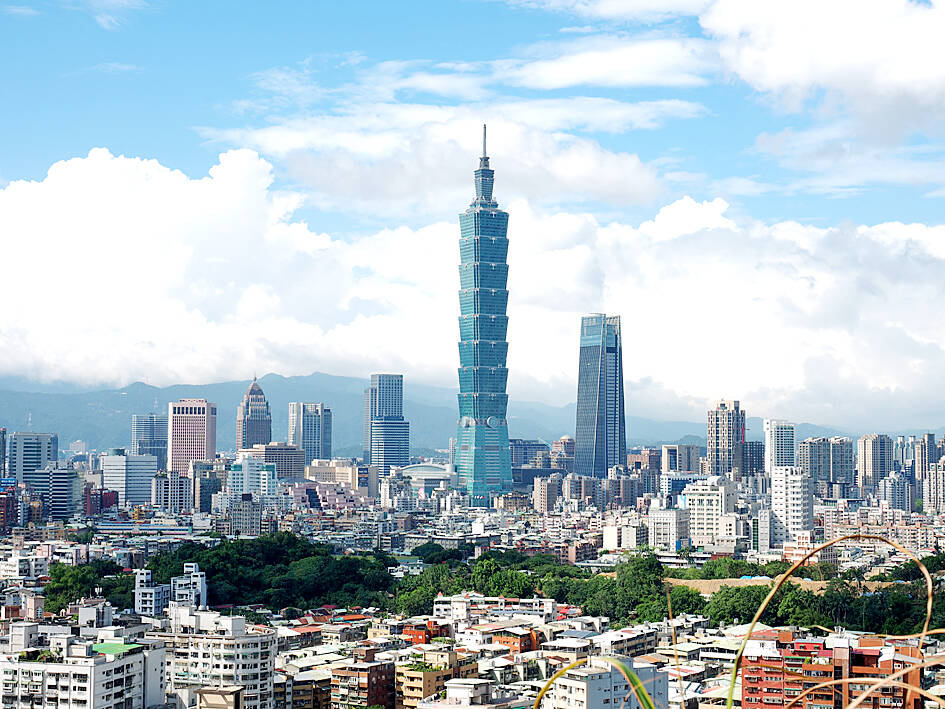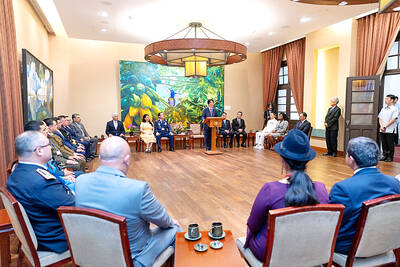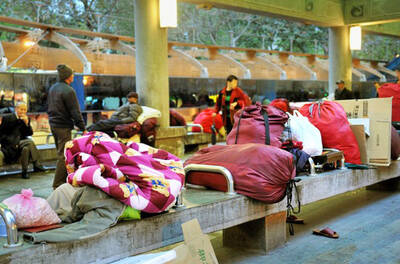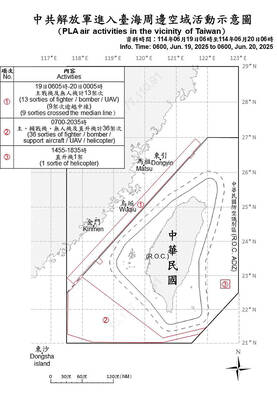Researchers have concluded a study on how weather and human activity influence Taipei 101’s frequencies and vibrations in an effort to enhance methods of monitoring building safety.
National Taiwan Normal University (NTNU) Department of Earth Sciences doctoral student Chen Yao-chieh (陳耀傑) and his team analyzed data from seismometers in Taipei 101 and meteorological data from the Xinyi weather station 1km away.
The study found that Taipei 101 has a higher frequency when temperatures rise, and a lower frequency when the wind blows vigorously, the university said in a statement on the study’s results.

Photo:EPA-EFE
Based on hourly data, the team found that human activity increased the vibrations detected by seismometers, it said.
Chen said that the “frequency” metric was significant because it is an important indicator of building safety.
Each building has its own frequency of vibration at different stages of its life span, he said, adding that new buildings have different frequencies than decades-old buildings.
Changes in frequency of a building due to material decay or structural renovation, which are usually observed through a process called “structural health monitoring,” could potentially affect its safety, he said.
Although data dating back to 2010 were included in the study, most of the research was based on data collected from 2014, as other data were affected by repairs or spotty Internet connections in the building, NTNU said.
Chen said the study not only has implications for Taipei 101 and other skyscrapers, but also for all buildings and bridges in Taiwan, which are prone to natural disasters such as earthquakes and typhoons.
Although sensors have been fitted on some bridges and buildings, the data that has been collected around Taiwan has not been continuous or even suitable for long-term purposes, in part because of the high cost of the equipment and labor, he said.
The government should start monitoring weak, older buildings or those believed to be unsafe, and later expand to more communities to enhance data-gathering methods, he said.
The research team also included NTNU earth sciences professor Kate Chen (陳卉瑄) and Huang Bor-shouh (黃柏壽) of the Academia Sinica Institute of Earth Sciences, the statement said.
The study was the cover story of the April edition of the Bulletin of the Seismological Society of America, a US journal for earthquake studies.

Costa Rica sent a group of intelligence officials to Taiwan for a short-term training program, the first time the Central American country has done so since the countries ended official diplomatic relations in 2007, a Costa Rican media outlet reported last week. Five officials from the Costa Rican Directorate of Intelligence and Security last month spent 23 days in Taipei undergoing a series of training sessions focused on national security, La Nacion reported on Friday, quoting unnamed sources. The Costa Rican government has not confirmed the report. The Chinese embassy in Costa Rica protested the news, saying in a statement issued the same

Taiwan’s Liu Ming-i, right, who also goes by the name Ray Liu, poses with a Chinese Taipei flag after winning the gold medal in the men’s physique 170cm competition at the International Fitness and Bodybuilding Federation Asian Championship in Ajman, United Arab Emirates, yesterday.

A year-long renovation of Taipei’s Bangka Park (艋舺公園) began yesterday, as city workers fenced off the site and cleared out belongings left by homeless residents who had been living there. Despite protests from displaced residents, a city official defended the government’s relocation efforts, saying transitional housing has been offered. The renovation of the park in Taipei’s Wanhua District (萬華), near Longshan Temple (龍山寺), began at 9am yesterday, as about 20 homeless people packed their belongings and left after being asked to move by city personnel. Among them was a 90-year-old woman surnamed Wang (王), who last week said that she had no plans

‘SPEY’ REACTION: Beijing said its Eastern Theater Command ‘organized troops to monitor and guard the entire process’ of a Taiwan Strait transit China sent 74 warplanes toward Taiwan between late Thursday and early yesterday, 61 of which crossed the median line in the Taiwan Strait. It was not clear why so many planes were scrambled, said the Ministry of National Defense, which tabulated the flights. The aircraft were sent in two separate tranches, the ministry said. The Ministry of Foreign Affairs on Thursday “confirmed and welcomed” a transit by the British Royal Navy’s HMS Spey, a River-class offshore patrol vessel, through the Taiwan Strait a day earlier. The ship’s transit “once again [reaffirmed the Strait’s] status as international waters,” the foreign ministry said. “Such transits by